ContentslistsavailableatScienceDirect
International Journal of Heat and Mass Transfer
journalhomepage:www.elsevier.com/locate/hmt
Analysis of mixed convective heat transfer from a sphere with an aligned magnetic field
B. Hema Sundar Raju
a, Dipjyoti Nath
a, Sukumar Pati
b, László Baranyi
c,∗aDepartment of Mathematics, National Institute of Technology Silchar, Silchar 788 010, India
bDepartment of Mechanical Engineering, National Institute of Technology Silchar, Silchar 788 010, India
cDepartment of Fluid and Heat Engineering, Institute of Energy Engineering and Chemical Machinery, University of Miskolc, 3515 Miskolc-Egyetemváros, Hungary
a rt i c l e i n f o
Article history:
Received 23 March 2020 Revised 29 July 2020 Accepted 12 August 2020
Keywords:
Sphere flow separation magnetic field mixed convection Nusselt number
a b s t r a c t
Numericalcomputationsareperformedtoexaminetheflowandheattransfercharacteristicsformixed convectiveflowpastasphereinanassistingflowarrangementwithanalignedmagneticfield.Theflow isconsidered aslaminar, steadyand incompressibleand theworkingfluidsas Newtonian.Aspherical geometry higherordercompact scheme(SGHOCS) isemployed tosolve theset ofnon-linear govern- ingtransportequations.Theresultsareenumeratedintermsofstreamlines,isotherms,dragcoefficient togetherwithlocalandaverageNusseltnumberonthesurfaceofthespherebyvaryingthefollowingpa- rameters:Reynoldsnumber1≤Re≤200;Prandtlnumber0.72and7;Richardsonnumber0≤Ri≤1.5;
interactionmagneticparameter0≤N≤10.ForlowervaluesofRi,althoughtheflowseparationphe- nomena inthedownstream regionsuppressesfor weakerstrengthofthe magneticfield (N≤0.5), it againincreasesonfurtherincreaseinN.ForhighervaluesofRi,withanincreaseofN,theflowsepara- tionphenomenacompletelysuppresses.Thedragcoefficient(CD)increaseswithNforanyvaluesofRe, RiandPrandforN≥1,CD=K√
N+BwhereKandBareconstantsthatdependsonRiandPrandK= 0.32forRi=0whichisconsistentwiththeresultsintheliterature.OnthebasisofvariationofNuon thespheresurface,threedifferentregionsareidentifiedandmoreoverastronginterplaybetweenNand Riindictatingthecharacteristicofheattransferisfoundfor allvalues ofRe.Inthemixedconvection domaintheaverageNusseltnumber(Nu)firstdecreaseswithNandthentendstoaconstantvaluefor highervaluesofReynoldsnumber,incontrastwiththeforcedconvectioncase,whenNudecreaseswith NandthentendstoincreasealmostlinearlywithN.Basedonthenumericalresultsfortheconsidered rangeofparameters,correlationsaredevelopedforCD andNu,whicharerelativelyingoodagreement withreportedresultsintheliteratureforspecialcasesofbothforcedandmixedconvectiveflowspasta sphereintheabsenceofamagneticfield.
© 2020TheAuthor(s).PublishedbyElsevierLtd.
ThisisanopenaccessarticleundertheCCBY-NC-NDlicense.
(http://creativecommons.org/licenses/by-nc-nd/4.0/)
1. Introduction
Inrecenttimes,researchershaveputsignificant effortintoan- alyzing the hydrodynamic andthermal transport phenomenafor flow over bluff bodies due to various applications, such as de- sign ofheat exchangers, cooling of electronic chips,cooling tow- ersusedinsteelandoilindustries,spinnersinfoodprocessingin- dustries, coolingcircuit ofnuclear reactors, etc. Whenan electri- callyconductingfluidflowspastasolidobjectsubjectedtoanex-
∗ Corresponding author.
E-mail addresses: sukumar@mech.nits.ac.in (S. Pati), arambl@uni-miskolc.hu (L.
Baranyi).
ternallyimposedmagneticfield,itgeneratesaresistingeffectdue toLorentzforceandaccordinglytheflowphysics becomesconvo- lutedbecauseof theinterplayof differentforces,namely, inertia, viscous,buoyancyandLorentz forces.Theflowseparationandthe heat transfer ratecan be modulated through the strength of the appliedmagneticfield aswell asthebuoyantforce. Thisnecessi- tatesa thorough investigation to analyze the transport phenom- enaformagnetohydrodynamic(MHD)mixedconvectiveflow past aheatedsphere.
NumericalworkshavebeenreportedonMHDforced[1–11]as wellasmixedconvective[12,13]flowpasta cylinder.Kumariand Bansal [1] considered Oseens approximation to study the drag coefficient for MHD flow past a circular cylinder for different https://doi.org/10.1016/j.ijheatmasstransfer.2020.120342
0017-9310/© 2020 The Author(s). Published by Elsevier Ltd. This is an open access article under the CC BY-NC-ND license.
( http://creativecommons.org/licenses/by-nc-nd/4.0/ )
Nomenclature
CD totaldragcoefficient d diameter(sphere),m R radius(sphere),m FD totaldragonthesphere,N g gravitationalacceleration,ms-2 Gr Grashofnumber
Nu localNusseltnumber Nu averageNusseltnumber p dimensionlesspressure Pr Prandtlnumber
r dimensionlessradialcoordinate (r,
θ
) sphericalindimensionlessform Re ReynoldsnumberN magneticfieldinteractionparameter Ri Richardsonnumber
T temperature,K
k unitvectorofdimensionlessfreestreamvelocity U∞ freestreamvelocity,ms-1
H∞ magneticfield,wbm-2 v dimensionlessvelocity y1,y2,y3 Cartesiancoordinates
vr dimensionlessradialvelocitycomponent vθ dimensionlessangularvelocitycomponent
α
thermaldiffusivity,m2s-1β
thermalvolumetriccoefficient,K-1σ
electricalconductivity,Sm-1θ
angularcoordinate dimensionlesstemperatureν
kinematicviscosity,m2s-1ξ
modifiedcoordinatedefinedasr=eξρ
density,kgm-3ψ
dimensionlessstreamfunctionω
dimensionlessvorticityφ
1 value ofθ
up towhichNu eitherincreasesorde-creases
φ
2 valueofθ
atwhichflowseparationstartsD drag
r radialcomponent
S surface
θ
angularcomponent∞ freestream
dimensionalparameters
Reynolds number(Re) and magnetic parameters. Josserand et al.
[2]experimentally studied the flow of liquidmetal past a cylin- der in presence of an aligned magnetic field to understand the pressuredistributionaroundthecylinder.RaoandSekhar[3]stud- iedtheMHDflowpastacircularcylinderusinga finitedifference method(FDM)forRe= 500 andinteraction parameter(N = 1.2) andtheyfoundthatforsmallvaluesofN,thedragdecreaseswith N and then increases withfurther increase of N. The MHDflow past a circular cylinder wasstudied by Sekhar etal. [4] by em- ployingFDMforN upto15 andReupto 40.The MHDflow past acircularcylinderwasstudiedbyKumarandRajathy[5]forReup to 100 anddifferent Hartmann number by employingFDM. The MHD flow past a circular cylinder was studied by Sekhar et al.
[6]byemployingFDM forlarge ReandN up to12. Sekharetal.
[7]analyzed theeffectofalignedmagneticfield ontheflowpast a circular cylinder by employingFDM for large Re and different Hartmann number. Yoon etal. [8] studied the MHD forced con- vection heat transfer past a cylinder by varying Reynolds num- ber,Prandtlnumberandmagnetic fieldinteraction parameterus-
ingspectralmethod.TheMHDforcedconvectionheattransferpast a solid cylinder in presence porous media wasstudied by Ghadi et al. [9] by employing finite volume method (FVM). The MHD forcedconvectiveheat transferfromacircularcylinderwasstud- iedby Sivakumar etal.[10]byemployingFDMfor0≤ Re≤40;
0.065≤Pr≤7and0≤N≤20.Theeffectofmagneticfieldonthe flowandheattransfercharacteristicsfromacircularcylinderwas studied by Aldoss etal. [11] analyticallyusing the non-similarity method.Themixedconvectionheattransferfromacylinderunder thepresenceofalignedmagneticfield wasstudiedby Udhayaku- maretal.[12]usingFDMfor0≤Ri≤3,0.72≤Pr≤7,0≤N≤7 andRe=20,40.RoyandGorla[13]studiedtheinfluenceofchemi- calreaction,magneticfieldandradiationonmixedconvectionflow ofpower-lawfluidpastahorizontalcylinderbyemployinganim- plicitFDM.
Severalresearchershavealsoanalyzedthetransportcharacter- istics both for mixed and forced convective flow past spherical objects. Yonas [14] conducted experiments to measure the drag forflowofliquidsodiumpasta spherewithanalignedmagnetic fieldhavinglargemagneticparameters.Theflowpastasphereand diskshasbeenstudiedexperimentallybyMaxworthy[15]inpres- enceofanalignedmagneticfield.Sekharetal.[16–20]conducted severalnumericalinvestigationstoanalyzeMHDforcedconvective flowandheattransferpastaspherebyvaryingRe,PrandN.They haveemployedbothsecond orderaccurate [16–19]andfourthor- deraccurate [20]schemes.HieberandGebhart [21]firstanalyzed themixedconvectiveheat transferfroman isothermalspherefor lowGrashofnumber(Gr)andPr=1byemployingtheasymptotic expansions.ChenandMucoglu[22]andWongetal.[23]analyzed theflowandheattransferphenomenaformixedconvectiononan isothermalsphereusingFDMandfiniteelementmethod(FEM)for Pr=0.7. Nguyenetal.[24] studiedtheproblemofmixedconvec- tionheattransferpastasphericalparticleusingaspectralmethod.
Themixedandforcedconvective heattransferpastan isothermal spherewasstudiedbyAlassaretal.[25]byemployingseriestrun- cation method forRi : 0 to 10, Pr = 0.71. The mixed convective heattransfer andfluid flowpasta hotisothermal sphericalparti- clewereanalyzed byBhattacharyyaandSingh[26] byemploying a third-order accurate upwindscheme for Pr = 0.72 andRi ≥1.
Kotouc etal. [27] studied the problemof mixedconvection heat transferpastanisothermalsphereinlossofaxissymmetrybyem- ploying spectral elementdecomposition methodfor0≤ Ri ≤0.7 and0.72 ≤Pr≤7.Ziskindetal.[28]andMograbietal.[29]con- ducted experiments to analyse the mixed convective heat trans- fer past a sphere in different flow directions for low Gr and Pr numbers.Rajuetal.[30]andNathetal.[31]analyzedthe mixed convective heat transfer past a heated sphere using SGHOCS for 1≤Re≤200,0≤Ri≤1.5and0.72≤Pr≤40.
Despiteextensive studies havebeen reportedin the literature on MHDforced convective heat transfer froma bluff body, anal- ysis on MHDmixed convective heat transfer andfluid flow past a sphere is lagging. Accordingly in the presentwork, the spher- ical geometry higher order compact scheme (SGHOCS) has been employedto analysetheflowandheattransfercharacteristicsfor mixedconvectiveflowpasta sphereinanassisting flowarrange- mentwithanalignedmagneticfield.
2. Formulationoftheproblem
Weconsiderlaminar,steady,incompressibleflowofNewtonian fluids(air andwater) past an isothermal sphere(diameter dand temperatureTs)inaverticallyupwarddirectionasshowninFig.1 (a).The freestreamvelocity andtemperatureofthefluidare U∞ andT∞,respectively,andanalignedmagneticfieldofstrengthH∞ isappliedexternally.Fluidpropertiesareconsideredconstantand Boussinesqapproximationisappliedforthedensityvariation.The
Fig. 1. (a) Schematic diagram describing the problem, (b) schematic diagram describing the type of the grid considered and (c) zoomed view of the grid near the sphere surface.
induced magnetic field is small as compared to the applied one and hence neglected. The following dimensionless quantities are defined
v
=v
U∞, p= p
ρ
U∞2,=TTs−T−T∞∞, Re=U∞d
ν
, Gr=β
g(
Ts−T∞)
d3ν
2 ,N=
σ
H∞2dρ
U∞ , Pr=ν α
, Ri=Gr Re2.
Thegoverningequationsofconservationofmass,momentum and energycanbewrittenindimensionlessformasfollows.
∇
·v=0, (1)(
v·∇ )
v=−∇
p+ 2Re
∇
2v+Ri2
k+N[
(
v× H)
×H] (2) andv·
∇
= 2RePr
∇
2. (3)
Here, Gr, Pr, Re, N and Ri are respectively the Grashof number, Prandtl number,Reynolds number, magnetic field interaction pa- rameterandRichardsonnumber.Eq.(2)canbeexpressedinterms
ofvorticityas
∇
×(
v×ω )
= 2Re[
∇
×( ∇
×ω )
]−Ri2
( ∇
×k
)
−N[
∇
×{ (
v×H)
×H}
], (4)where
ω
=∇
×v (5)isthe dimensionlessvorticity and k is unit vector ofdimension- lessfreestreamvelocity(seeFig.1(a)).Firstwewritetheexpres- sionfor
v
θ= −1rsin
θ ∂ψ
∂
r andthenv
r= 1 r2sinθ ∂ψ
∂θ
. Using r=eξ,Eqs.(5)to(3)canbewritteninsphericalcoordinateas
∂
2ψ
∂ξ
2 −∂ψ
∂ξ
+∂
2ψ
∂θ
2 −cotθ ∂ψ ∂θ
=−ω
e3ξsinθ
, (6)∂
2ω
∂ξ
2 +∂ω
∂ξ
+cotθ ∂ω ∂θ
+∂
2ω
∂θ
2 −ω
csc2θ
−RiRe 4eξ
∂
∂ξ
sinθ
+∂
∂θ
cosθ
+ NRe 2sin
θ
e−ξsin2
θ ∂ψ ∂θ
−sin2θ ∂
2ψ
∂ ξ∂ θ
+sin2
θ ∂
2ψ
∂θ
2 +cos2θ ∂
2ψ
∂ξ
2 −cos2θ ∂ψ ∂ξ
= Re 2sin
θ
e−ξ∂ψ
∂θ ∂ω
∂ξ
−∂ψ
∂ξ ∂ω
∂θ
+∂ψ
∂ξ ω
cotθ
−ω ∂ψ
∂θ
(7)
and
∂
2∂ξ
2 +∂
∂ξ
+cotθ ∂ ∂θ
+∂
2∂θ
2= RePr 2sin
θ
e−ξ∂ψ
∂θ ∂
∂ξ
−∂ψ
∂ξ ∂
∂θ
. (8)
Thefollowingboundaryconditionsareemployed:
ω
=−sin1θ ∂
2ψ
∂ξ
2,ψ
=∂ψ
∂ξ
=0,=1 at
ξ
=0, (9a)ψ
=12e2ξsin2
θ
,ω
==0 as
ξ
→∞, (9b)ψ
=0,ω
=0,∂
∂θ
=0atθ
=0andθ
=π
. (9c) The obtainedvelocityandtemperaturefieldsarecharacterized intermsoftwodimensionlessparametersnamely,dragcoefficient andNusseltnumber.Thedragcoefficientiscomputedfrom CD= FDρ
U∞2πd2 8=−8 Re
π
0
ω (
0,θ )
sin2θ
dθ
+4 Re
π
0
ω
+∂ω
∂ξ
ξ=0
sin2
θ
dθ
, (10)where,thefirsttermontheright-handsideofEq.(10)represents thedragcoefficientsduetoviscousforceandthesecondtermrep- resentsthecontributionofpressureforce.ThelocalNusseltnum- beronthespheresurfaceiscomputedasfollows
Nu=−2
∂
∂ξ
ξ=0
, 0≤
θ
≤π
. (11)Table 1
Results of domain independence analysis. The parameters used are: Re
= 200, Ri = 0.05, N = 0.1 and Pr = 0.72.
Domain size Nu % Difference C D % Difference
20 R 9.1871 — 0.9180 —
30 R 9.1824 0.052 0.9158 0.236
40 R 9.1797 0.029 0.9146 0.135
50 R 9.1773 0.026 0.9133 0.136
TheaverageNusseltnumberis Nu=1
2 π
0
Nu
( θ )
sinθ
dθ
. (12)3. Numericalmethodologyandvalidation
Higher ordercompact schemeinspherical geometryhasbeen usedtosolvetheconservationEqs.(6)-(8)together withbound- aryconditions(9a)-(9c).Thedetailsofdiscretizationandbound- aryconditionsarepresentedinSekharandRaju[32],Sekharetal.
[33], Rajuetal. [30,34],Nathetal.[31], NathandRaju[35].The algebraic equations as obtained after discretizing the governing equationsaresolvedbythetridiagonalmatrixalgorithm.Theitera- tionsarecontinueduntiltheL2normofrelativeresidualissmaller thanacertainconvergencecriterion
andinthispresentwork,
issetas10−6.
Tojustifythedomainsizeusedfortheanalysis,far-fielddomain independenceanalysisareconductedusingfourdifferentfar-field domains,particularly20,30,40and50timesradiusofthesphere.
The values of Nuand CD obtained by using domain of different sizesarepresentedinTable1forRe=200,Ri=0.05,N=0.1and Pr= 0.72.Itcan beseen fromTable 1thatthevaluesare almost same fortwo refined domains namely 40and 50(the changeof NuandCDare0.026%and0.135%,respectively,whenthedomain sizehaschangedfrom40Rto50R).Allnumericalsimulationshave been performedconsidering 40 timesradius of thesphere as an optimumfar-fielddomain.
Todemonstrate thegrid independenceanalysisof thepresent fourth order numerical code, the numerical computations have been conductedusing seven different grids, specifically 81 × 81, 101 × 101, 121 × 121, 141 × 141, 161 × 161, 181 × 181 and 201 × 201. The values of Nu, CD and p(0, 0) obtainedfrom the SGHOCSintheabovespecifiedgridsizesarepresentedinTable2 for Re= 200, Pr = 0.72, Ri = 0.05 andN = 0.1. It is seen from Table 2 that the values of CD, Nuand p(0, 0) are almost identi- cal fortwo consecutivegrids 181×181and201×201. Hencein thispresentstudy, all numericalsimulations have beendone us- ing 181×181 grids.The gridusedis showninFig.1(b),witha zoom-inofthegridnearthesphere’ssurfaceshowninFig.1(c).
Prior to conduct numerical experiments, we first validate our in-housecodeextensively.Firstly,thevaluesofCDandNuobtained fromthe SGHOCSare comparedin theabsence ofmagnetic field withthevaluesofNirmalkar etal.[36]in Table3atPr =10, Re
=0.1forvariousvaluesofRi.Itcan benoticedfromTable3that the presentresultsvary fromthose ofNirmalkar etal.[36] with amaximumrelativedifference0.099 %forCD and0.212%forNu. Next,thevaluesofNuobtainedfromthecurrentschemearecom- pared in the absence of magnetic field with the results of Nir- malkar and Chhabra [37] and Sreenivasulu and Srinivas [38] for differentRi (=1,1.5)atRe=100andPr=100,ascanbeseenin Table4.Finally,thevaluesofCDandNuobtainedfromthepresent scheme are validated with the results of Kotouc et al. [27] and Sreenivasulu andSrinivas [38] for Pr = 20,60,100, Re = 100, N
=0andRi=1inTable5.ItcanbenoticedfromTables3,4and 5that thepresentresultsare inlinewithresultsreportedinthe literature[27,36–38].
Table 2
Results of grid independence analysis. The parameters used are: Re = 200, Ri = 0.05, N = 0.1 and Pr = 0.72.
Grid size Nu % Difference C D % Difference p (0, 0) % Difference
81 ×81 9.0297 — 0.8303 — -0.1196 —
101 ×101 9.1144 0.929 0.8769 5.315 -0.1849 35.314 121 ×121 9.1519 0.410 0.8975 2.292 -0.2185 15.358 141 ×141 9.1683 0.179 0.9071 1.053 -0.2347 6.919 161 ×161 9.1759 0.083 0.9119 0.531 -0.2428 3.346 181 ×181 9.1797 0.041 0.9146 0.294 -0.2471 1.737 201 ×201 9.1816 0.021 0.9162 0.177 -0.2495 0.961
Table 3
Comparison of values of C Dand Nu with [36] for different Ri at Pr = 10, Re = 0.1 and N = 0.
Ri C D Nu
Nirmalkar et al. [36] Present
% Difference
Nirmalkar et al. [36] Present
% Difference 0 244.56 244.40 0.065 2.3081 2.3032 0.212 2 303.57 303.87 0.099 2.3448 2.3434 0.060
Table 4
Comparison of values of Nu with [37] and [38] for different Ri at Pr = 100, Re = 100 and N = 0.
Ri Nu
Nirmalkar and Chhabra [37]
Sreenivasulu and Srinivas [38] Present
% Difference with [37]
% Difference with [38]
1 34.829 34.930 34.334 1.441 1.736
1.5 35.607 36.670 35.186 1.196 4.218
Table 5
Comparison of values of C Dand Nu with [27] and [38] for different Pr at Ri = 1, Re = 100 and N = 0.
Pr C D
Kotouc et al.
[27]
Sreenivasulu and Srinivas [38] Present
% Difference with [27]
% Difference with [38]
20 1.41 1.46 1.39 1.418 4.794
60 1.38 1.38 1.35 2.174 2.174
100 1.32 1.34 1.34 1.515 0
Pr Nu
Kotouc et al.
[27]
Sreenivasulu and Srinivas [38]
Present % Difference with [27]
% Difference with [38]
20 22.10 21.20 21.32 3.529 0.566
60 30.08 29.80 29.59 1.629 0.705
100 35.00 34.93 34.33 1.914 1.718
4. Resultsanddiscussion
The problem of mixedconvection heat transfer past a sphere withan alignedmagneticfield is consideredin thepresentwork by employing SGHOCS. The working fluids are considered asair (Pr = 0.72) and water (Pr = 7). The numerical computations are performed for different parameters in the following range 1≤Re≤200,0≤Ri≤1.5,0≤N≤10.Theresultsarepresented intermsofstreamlines,isotherms,coefficientofdrag,localandav- erageNusseltnumbers.
Tointerprettheintricacyinvolvedassociatedwiththetransport phenomena, we firstanalyse theflow andthermalfieldsthrough thestreamlines,-andisothermsaspresentedinFigs.2and3for differentvaluesofN(=0,0.25,0.5,5),Ri(=0,0.1,0.25,1.5)with Pr=0.72andRe=200.Forforcedconvectiveflowpastthesphere (Ri =0), intuitively theflow separationtakesplace inthedown- stream region without impositionof magnetic field (N = 0). Al-
though with the imposition of external magnetic field, the flow separationphenomenasuppresses initiallyforweaker strength of themagneticfield(N≤0.5),itagainincreasesonfurtherincrease inN.ForlowervaluesofRi(≤0.1),theeffectofNonthedistribu- tionofstreamlinesisqualitativelysimilartothecaseofRi=0i.e, withincreaseinN,theflowseparationphenomenafirstsuppresses slightlyand then againincreaseswith further increase in N. The flowpatternsaredistinctly differentforhighervaluesofRiascan be seen inFig. 2. Forhighervalues of Ri, withan increase of N, theflowseparationphenomenastartssuppressingandfinallycom- pletely suppresses. Itcan be summarized that forany specific N, thereisacompletesuppressionoftheflowseparationphenomena withanincrease ofRialthoughthevalue ofRiatwhichcomplete suppressiontakes placedependson N. Thus,the phenomenon of flowseparationthatwouldoccurformagnetohydrodynamicforced convectiveflowpastasphereforaparticularReynoldsnumberis suppressedoncetheRichardsonnumberisaboveitscriticalvalue, themagnitudeofwhichvarieswiththemagneticfieldparameter.
Theheattransfercharacteristicsforthecurrentworkcanbeex- plained through the distribution of isotherms around the sphere andaccordinglyFig.3displaystheisothermsaroundthespherefor differentvaluesofRi,NwithPr=0.72atRe=200.Itcanbeseen fromFig. 3 that the distribution of isotherms is strongly depen- dentonRi andN.Foranyspecificvalue ofN andRi,thethermal boundarylayerthickness(
δ
T)isminimumatthefront stagnation point,whileitismaximumattherearstagnationpointandthere isa continuousvariation ofthe thicknessthroughout thesurface of the sphere. At the front stagnation point, the thickness again varieswithbothNandRiandmorespecifically,δ
Tdecreaseswith increaseinRianddecreaseinN.Thedistributionoftheisotherms in the region of rear stagnation point is distinctly different de- pending on whether there is any flow separation or not. It can be clearlyseen that forlower values of Ri andN,δ
T at the rear stagnationpoint isminimumforN = 0andit increaseswithin- creaseinbothNandRi.Itcanbeseenthatintheupstreamregion (180◦ ≤θ
≤φ
1),δ
T increaseswithchangeinθ
from180◦ toφ
1forN ≤ 1,while forN > 1,reverse trend isobserved. Important tomentionherethat,thevalue of
φ
1 stronglydependson Nand Ri.Whenθ
changesfromφ
1 toavaluewhereflowseparationini- tiates,δ
T increasescontinuouslyandmoreover,δ
Tdecreases with N.Figure4presentstheeffectofNondragcoefficientfordifferent valuesofRi,Pr=0.72,7andRe=10,100,200.Itisseenthatfor anyparticularvalue ofRi,ReandPr,CD increaseswithN because oftheincreasedresistingLorentzforce.Importanttonote thatCD decreaseswithincrease inbothReandPr,whileitincreaseswith Rikeepingotherparametersfixed.Althoughtherelativecontribu- tionsofskinfriction andformdragonthetotaldragare changed forlower andhigher values of Ri andRe, both skin friction and formdragdecreaseswithincreaseinReandtheyincreasewithin- creaseinRi.Suchvariationcanbeexplainedfromthedependency ofthewakesizeinthedownstreamregionwithReandthechange ofhydrodynamicboundarylayerthicknesswithRi.Anotherimpor- tantfeaturethatcanbe notedfromtheinsetsofFig.4isthatfor
Fig. 2. Streamlines around the sphere for different values of Ri = 0, 0.1, 0.25, 1.5, N = 0, 0.25, 0.5, 5 and Pr = 0.72 at Re = 200.
0.05 0.
20
0.35 0.40 0.45
N = 0
Ri=0
-2 -2
-1 -1
0 0
1 1
2 2
-2 -2
-1 -1
0 0
1 1
2 2
3 3
4 4 0.05
0.
20
0.35
0.45 0.40
N = 0.25
-2 -2
-1 -1
0 0
1 1
2 2
-2 -2
-1 -1
0 0
1 1
2 2
3 3
4 4
0.05
0.20
0.40 0.35
0.45
N = 0.5
-2 -2
-1 -1
0 0
1 1
2 2
-2 -2
-1 -1
0 0
1 1
2 2
3 3
4 4
0.20
0.35
0.05
0.45 0.40
N = 5
-2 -2
-1 -1
0 0
1 1
2 2
-2 -2
-1 -1
0 0
1 1
2 2
3 3
4 4
0.05
0.20
0.35
0.45 0.40
Ri=0.1
-2 -2
-1 -1
0 0
1 1
2 2
-2 -2
-1 -1
0 0
1 1
2 2
3 3
4 4 0 0.05
.20
0.40 0.35
0.45
-2 -2
-1 -1
0 0
1 1
2 2
-2 -2
-1 -1
0 0
1 1
2 2
3 3
4 4
0.05
0.40 0.35
0.45
0.20
-2 -2
-1 -1
0 0
1 1
2 2
-2 -2
-1 -1
0 0
1 1
2 2
3 3
4 4 0.05
0.35
0.40 0.45
0.20
-2 -2
-1 -1
0 0
1 1
2 2
-2 -2
-1 -1
0 0
1 1
2 2
3 3
4 4
0.05
0.20
0.40
0.45 0.35
Ri=0.25
-2 -2
-1 -1
0 0
1 1
2 2
-2 -2
-1 -1
0 0
1 1
2 2
3 3
4 4 0.05
0.20
0.35
0.4 0 0.45
-2 -2
-1 -1
0 0
1 1
2 2
-2 -2
-1 -1
0 0
1 1
2 2
3 3
4 4 0.05
0.20
0.35
0.40 0.45
-2 -2
-1 -1
0 0
1 1
2 2
-2 -2
-1 -1
0 0
1 1
2 2
3 3
4 4 0.0
50.20
0.35
0.40 0.
45
-2 -2
-1 -1
0 0
1 1
2 2
-2 -2
-1 -1
0 0
1 1
2 2
3 3
4 4
0.05
0.20
0.40
Ri=1.5
-2 -2
-1 -1
0 0
1 1
2 2
-2 -2
-1 -1
0 0
1 1
2 2
3 3
4 4
0.05
0.20
0.40
-2 -2
-1 -1
0 0
1 1
2 2
-2 -2
-1 -1
0 0
1 1
2 2
3 3
4 4 0.0
5
0.20
0.40
-2 -2
-1 -1
0 0
1 1
2 2
-2 -2
-1 -1
0 0
1 1
2 2
3 3
4 4 0
.05
0.20
0.40
-2 -2
-1 -1
0 0
1 1
2 2
-2 -2
-1 -1
0 0
1 1
2 2
3 3
4 4
Fig. 3. Isotherms around the sphere for different values of Ri = 0, 0.1, 0.25, 1.5, N = 0, 0.25, 0.5, 5 and Pr = 0.72 at Re = 200.
Fig. 4. The C Dvalues for different values of Ri, N, Pr = 0.72, 7 and Re = 10, 10 0, 20 0. The linear dependence of C Dwith √
N ( N > 1) for different Ri and Pr values at Re = 200. Numbers in brackets represent the slopes of the linear fitting of the √
N data (inset).
anyspecific values of Pr and Ri, the variation of dragcoefficient with√
N islinearforN ≥ 1anda functionalrelationship canbe established asfollows:CD=K√
N+Bwhere K = 0.32 forRi = 0 andthevalueofKincreaseswithRianddecreaseswithPr.More- over,thevalue ofBisdifferentfordifferentcombinationsofN,Ri andPr. The present resultsare consistent withthe experimental findings[14]forRi = 0andreportedasK =0.33 fortheflow of sodiumpastsphereanddisks.
A correlation forthedragcoefficient (CD) asa functionof the relevantparametersisdevelopedasfollows:
CD= 24
(
1+0.16621Re0.66852+aNb+cRid)
Re , (13)
wherea, b,c anddare coefficients,that areindependentofRi in therange,0≤Ri ≤1.5andN intherange 0≤N ≤10,butthat aredependentonReandPrasgivenbelow:
a=0.12041+0.05476Re−0.00131Re2 +1.59737×10−7Re3,b=0.71,
c=0.26132+0.170747Re−0.00314Re2+3.79749×10−5Re3and d=0.89865for1≤Re≤40andPr=0.72.
a=0.4634+0.01994Re−5.61798×10−6Re2 +2.71268×10−9Re3,b=0.63,
c=0.94521+0.09344Re−1.2057×10−4Re2 +2.4330×10−7Re3 and
d=1.03207for40<Re≤200andPr=0.72. a=0.15307+0.04388Re−0.00111Re2
+1.42223×10−5Re3,b=0.7, c=0.14904+0.11964Re−0.00154Re2
+1.77406×10−5Re3 and
d=0.94509for1≤Re≤40andPr=7. a=0.36027+0.0175Re−6.92398×10−6Re2
+1.43595×10−8Re3,b=0.6545,
c=0.59994+0.07771Re−5.84347×10−5Re2 +1.00494×10−7Re3and
d=0.97373for40<Re≤200andPr=7.
The presentdragcoefficient correlation (Eq.(13)) correlatesto thepresentnumericaldatawithamaximumandaveragepercent- age difference of 16.63% and 4.18%, respectively. Furthermore, a comparisonoftheresultsofCD obtainedfromthecorrelationde- velopedinthisanalysisismadewithresultsavailableinliterature forforcedaswell asmixedconvectionpast asphere whenthere isnomagneticfield(N=0).Inthiscontext,FengandMichaelides [39]proposedacorrelationforCDfortheforcedconvectionpasta spherewithoutmagneticfield(Ri=0;N=0)as
CD=24
1+0.167Re0.67
Re . (14)
Themaximumandaveragepercentagedifferencesbetweenthere- sults obtained from the present correlation and by Eq. (14) are 0.46% and 0.20%, respectively. For the mixed convection past a sphere without magnetic field (N = 0), the results for CD as obtained from the present correlation are compared with Bhat- tacharyyaandSingh[26]for1≤Re≤200,Ri=0,0.5and1.5,and Pr = 0.72 (Fig.5). It isshown inFig. 5 that theresults obtained fromthepresentcorrelationareinverygoodagreementwiththe publishedresults.
The temperature field is parametrized by Nusselt number to represent the rate of heat transfer from the sphere to the sur- roundingfluidflowingoverit.Fig.6displaystheangularvariation of local Nusselt number(Nu) on the sphere surface for different valuesofRi,NwithPr=0.72,7andRe=200.Firstofall,onecan seefromFig.6thatforanyspecificvaluesofRi,NandPr,thereis acontinuousvariationofNualongthesurfaceofthespherewith a maximum value atthe front stagnationpoint (
θ
=180◦) anda minimumone attherear stagnationpoint(θ
=0◦)which canbe explainedfromthedistributionofisothermsaroundthesphere.An intricateinterplaybetweenthebuoyantforceasrepresentedbyRi andtheLorentz forceduetoimpositionofapplied magneticfield asrepresentedbyNcanbeseeninalteringtheheattransferphe- nomena.ForN≤1,andlowervaluesofRi(≤0.25),Nudecreases fromθ
=180◦ to a point slightlyaway fromthe flow separation point and thereafter increases tillθ
=0◦. WhereasNu decreases continuously fromfront stagnationpoint to rear stagnationpoint forhighervaluesofRiandthisisapplicabletoboththefluidscon- sideredintheinvestigation.ForN≥2,Nuincreasesalongthesur- face ofthesphere fromθ
=180◦ toa particularpointandthere- after decreases untilθ
=0◦ forhigher values ofRi.However, for lower values of Ri, Nu increases along the surfaceof the sphere fromθ
=180◦ to a particular point, then decreases near to flow separationpointandbeyondtheseparationpointitagainincreases tillθ
=0◦ andthisismoreprominentforPr= 7.0.Three regions havebeenidentifiedwithrespecttotheangularvariationofNu.In thefirstregion (180◦ ≤θ
≤φ
1),Nueitherdecreases orincreases asonemovesfromthefrontstagnationpointtoθ
=φ
1 depending onthestrengthoftheappliedmagneticfield.NotethatforN≤1, Nu decreases, while N > 1, Nu increases.The value ofφ
1 varies from140◦ to80◦ dependingonthevaluesofN andRi.Inthesec- ond region(φ
1 ≤θ
≤φ
2),Nu monotonicallydecreases alongthe surfaceof the sphere andinthe third region (φ
2 ≤θ
≤ 0◦), Nu again increases.The existence ofthird region totally dependson whetherthereisflowseparationinthedownstreamregionornot.Forexample,forRi=1.5,thirdregionisabsentforbothPr=0.72
Fig. 5. Comparison of present correlation values of C Dwith [26] for different values of Re, Ri = 0, 0.5 and 1.5 at Pr = 0.72 and N = 0.
Fig. 6. Angular variation of Nu on the sphere surface for different values of Ri, N and (a) Pr = 0.72 and (b) Pr = 7 at Re = 200.
Fig. 7. Variation of Nu with N for different values of Ri at Re = 200 and Pr = 0.72, 7.
and 7 because of the fact there is no flow separation as can be seeninFig.6.Thiscanbe explainedfromthevariationofsurface vorticityalongthesurfaceofthesphereandtheconsequenceofit inalteringthethermalboundarylayerthickness.
Figure7displaysthevariationofaverageNusseltnumber(Nu) withN fordifferentvaluesofRi withPr= 0.72,7andRe=200.
ForanyspecificvalueofN,NuincreaseswithRi,ReandPr,which is intuitive and well established in the literature. Starting from flowseparationuptoacriticalReynoldsnumber,anon-monotonic (decreasing-increasing) trendofNuwithN isobservedforforced convective flowaswellasmixedconvectionwithlower valuesof Ri,while for higher valuesof Ri, Nu increasescontinuously with N.Althoughthetrend(decreasing-increasing)forforcedconvective flowisthesameevenforhighervaluesofRe,formixedconvection NufirstdecreaseswithNandthenittendstoaconstantvalue.For Re= 200,bothforPr =0.72 and7.0,the variationofNuisnon- monotonic withN for all Ri.The variation of Nu withN can be explainedthroughcloseinspectionacompetingeffectofchangein NuwithNatfrontstagnationpoint,theangularvariationofNuin thefirstregion(180◦≤
θ
≤φ
1),therateofdecrementofNuinthe second region(φ
1 ≤θ
≤φ
2) andtheincreaseinNu inthethird regionduetotheoccurrenceofflowseparation.Fig. 8. Isosurfaces of Nu for different values of Ri, N and Re with Pr = 0.72, 7.0.
Theresultsofaverage Nusseltnumber(Nu)for1≤ Re≤200, 0≤Ri ≤1.5,0≤N≤10andPr=0.72and7arerepresentedby isosurfacesinthe3DphasespaceinFig.8.Thisclearlyshowsthat NuincreaseswithRe,RiandPr.Itisobservedthatthevariationof NuwithNisnotmonotonicexceptformixedconvectiveflowwith highervaluesofNandintermediateRe.Further,thevariationofNu withNis distinctly differentformixedconvectionandforforced convection,especiallyathighervaluesofRiandRe.
Acorrelationforthe averageNusseltnumber(Nu) intermsof therelevantparametersisdevelopedasfollows:
For1≤Re≤40
Nu=0.90968+0.295Ri+
(
PrRe)
1/3+0.12404Pr1/3Re2/3 1+0.01581N2/5Pr−1/4Re4/91/5for0≤N≤N∗, (15)
Nu=1.29095+0.295Ri+
(
PrRe)
1/3+0.19426Pr1/3Re2/3 1+0.0337822/5 Pr−1/4Re4/91/5(
0.85233+0.00349N)
Table 6
Comparison of present correlation values of Nu with [40–43] for Pr = 0.72, 7, Ri = 0, 1 ≤ Re ≤200 and N = 0.
Correlation Authors
Maximum
% difference
Average % difference Nu = 2 . 0 + (0 . 4 R e 12 + 0 . 06 R e 23)P r 0.4 Whitaker [40] 17.045 6.260 Nu = 2 . 0 + 0 . 9 (Re Pr)R e 0.11
1 . 8 R e 0.11+ (Re Pr )23 Finlayson Olson [41] and
12.032 4.481 Nu = 0 . 922 + (RePr)13 + 0 . 1 R e 23P r 13 Feng and
Michaelides [42]
8.7305 3.111 Nu = 0 . 852 (RePr)13(1 + 0 . 233 R e 0.287)
+ 1 . 3 −0 . 182 R e 0.355
Feng and Michaelides [43]
8.013 3.161
forN∗<N≤10. (16)
For40<Re≤200
Nu= 0.15788+1.295Ri+
(
PrRe)
1/3+0.12377Pr1/3Re2/3 1+0.00639N2/5Pr−1/4Re4/91/5for0≤N≤N∗, (17)
Nu= 0.55149+1.295Ri+
(
PrRe)
1/3+0.15835Pr1/3Re2/3 1+0.0267922/5 Pr−1/4Re4/91/5(
0.91407+0.000545803N)
forN∗<N≤10. (18)
NotethatN∗ varieswithRi,ReandPrandgivenas
N∗=a1+b1Ric1+d1Ree1, (19) where
a1=−0.64768,b1=−0.89504,c1=1.07915, d1=0.24314,e1=0.53376
for 1≤Re≤40andPr=0.72,
a1=−3.21396,b1=0.42201,c1=2.75536×10−9, d1=0.26156,e1=0.6554
for40<Re≤200 andPr=0.72.
a1=−0.65688,b1=0.13273,c1=0.10529, d1=0.19269,e1=0.46233
for1≤Re≤40andPr=7,
a1=−3.14538,b1=1.7845,c1=0.7034, d1=0.159474,e1=0.70637
for40<Re≤200 andPr=7andallthecorrelationsare valid for0≤Ri≤1.5.
The present average Nusselt number correlation correlates to thepresentnumericaldatawithmaximumandaveragepercentage differenceof13.66%and1.97%,respectively.Furthermore,theaccu- racyofthedevelopedcorrelationforNuisverifiedthroughexten- sivecomparisonoftheresultswiththat availableinliterature for forcedaswell as mixedconvectionpast a sphere inthe limiting situationof no magnetic field. Table 6 showsthe maximum and averagepercentagedifferencesbetweentheresultsobtainedfrom thepresentcorrelation andreportedin theliterature [40–43] for Ri = 0,N = 0. For the mixed convection past a sphere without amagnetic field (N = 0),the resultsfor averageNusselt number asobtainedfromthepresentcorrelationarecomparedwithBhat- tacharyyaandSingh[26] for1≤ Re≤ 200,Ri =0.5and1.5and Pr=0.72(Fig.9).ItisfoundfromFig.9thattheresultsobtained fromthepresentcorrelationare inverygoodagreementwiththe publishedresults.
Fig. 9. Comparison of present correlation values of Nu with [26] for different values of Re, Ri = 0.5 and 1.5 with Pr = 0.72 and N = 0.
5. Conclusions
Themixedconvectionheattransferpastaspherewiththepres- enceofanalignedmagneticfieldhasbeenstudiedbyimplement- ingSGHOCS.Theflowisconsideredaslaminar,steadyandincom- pressible andtheworkingfluidsasNewtonian. Thefollowing are theimportantfindingsfromthecurrentnumericalinvestigations:
• ForlowervaluesofRi,althoughtheflowseparationphenomena inthedownstreamregionsuppressesforweakerstrengthofthe


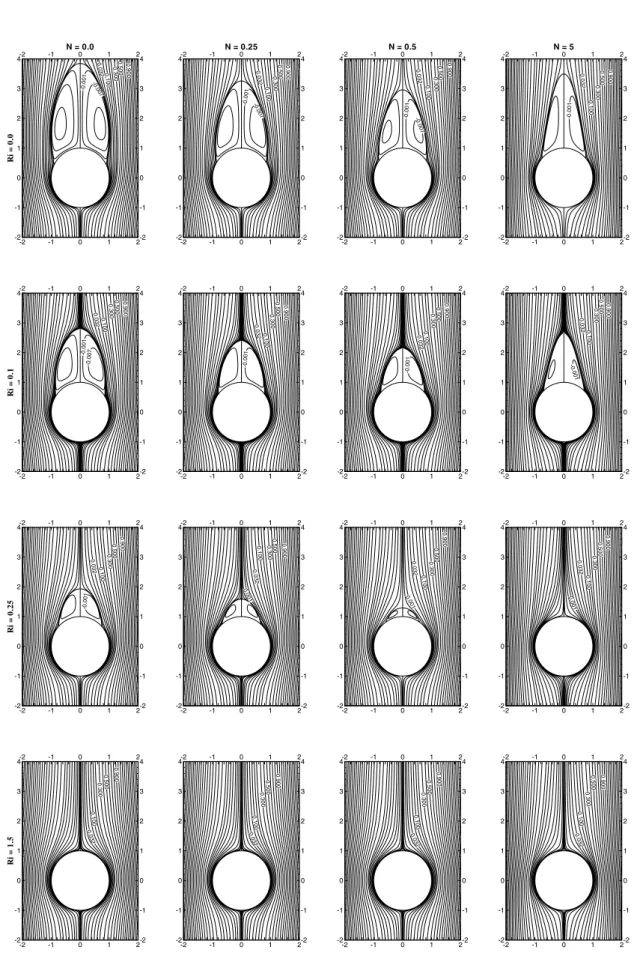
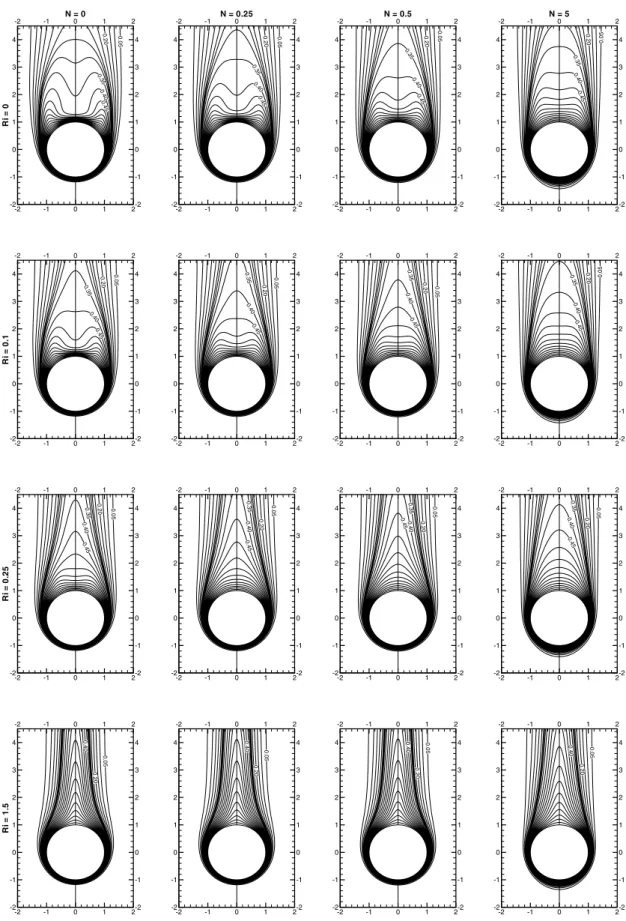
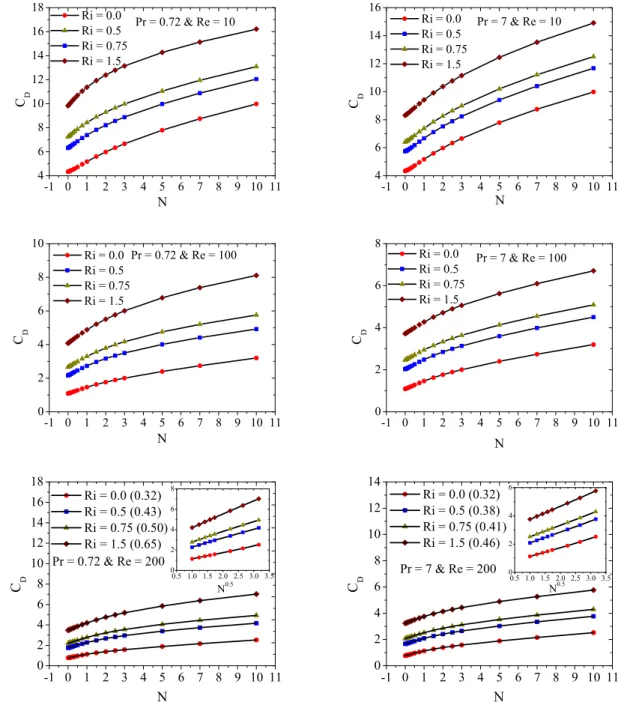
![Fig. 5. Comparison of present correlation values of C D with [26] for different values of Re, Ri = 0, 0.5 and 1.5 at Pr = 0.72 and N = 0](https://thumb-eu.123doks.com/thumbv2/9dokorg/788853.36810/9.892.478.828.123.1041/fig-comparison-present-correlation-values-different-values-ri.webp)
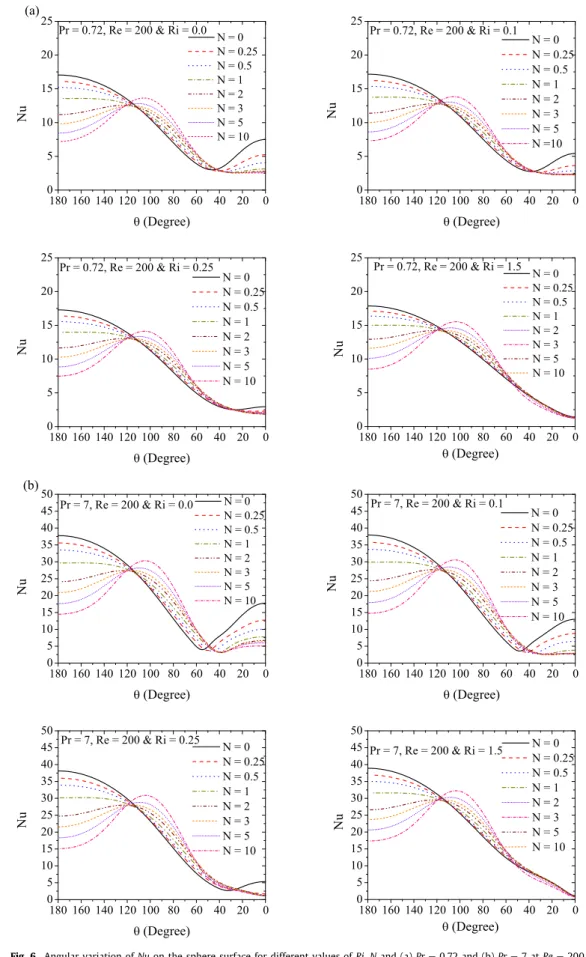
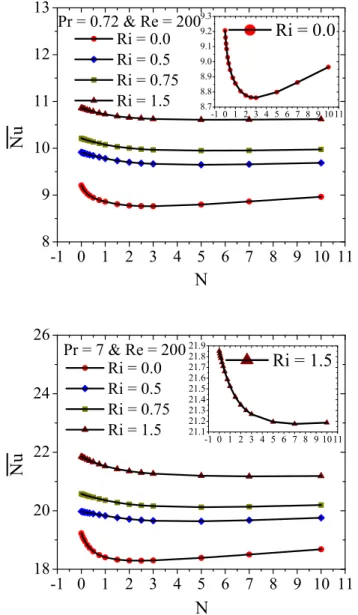
![Fig. 9. Comparison of present correlation values of Nu with [26] for different values of Re, Ri = 0.5 and 1.5 with Pr = 0.72 and N = 0](https://thumb-eu.123doks.com/thumbv2/9dokorg/788853.36810/12.892.454.813.258.898/fig-comparison-present-correlation-values-nu-different-values.webp)